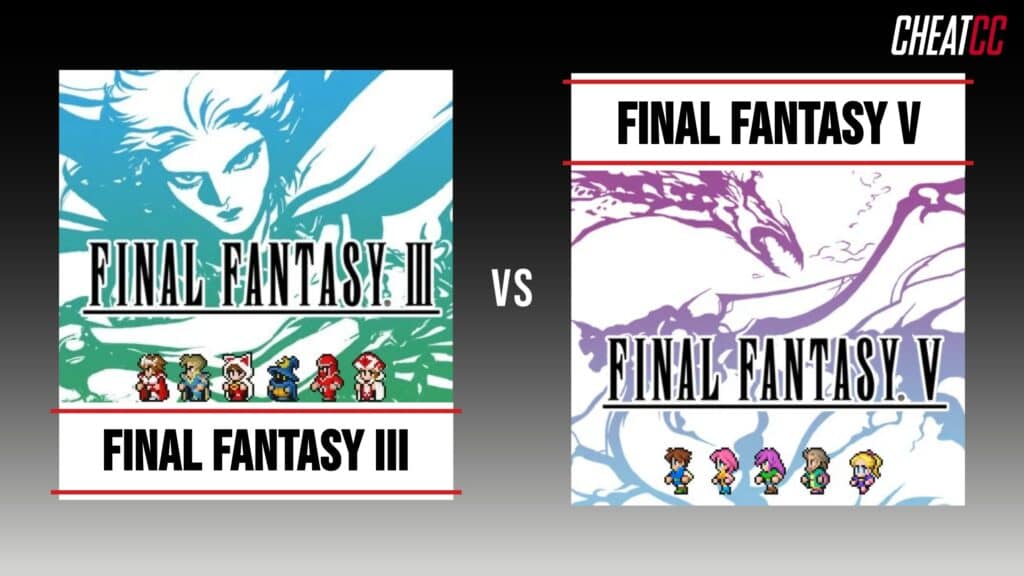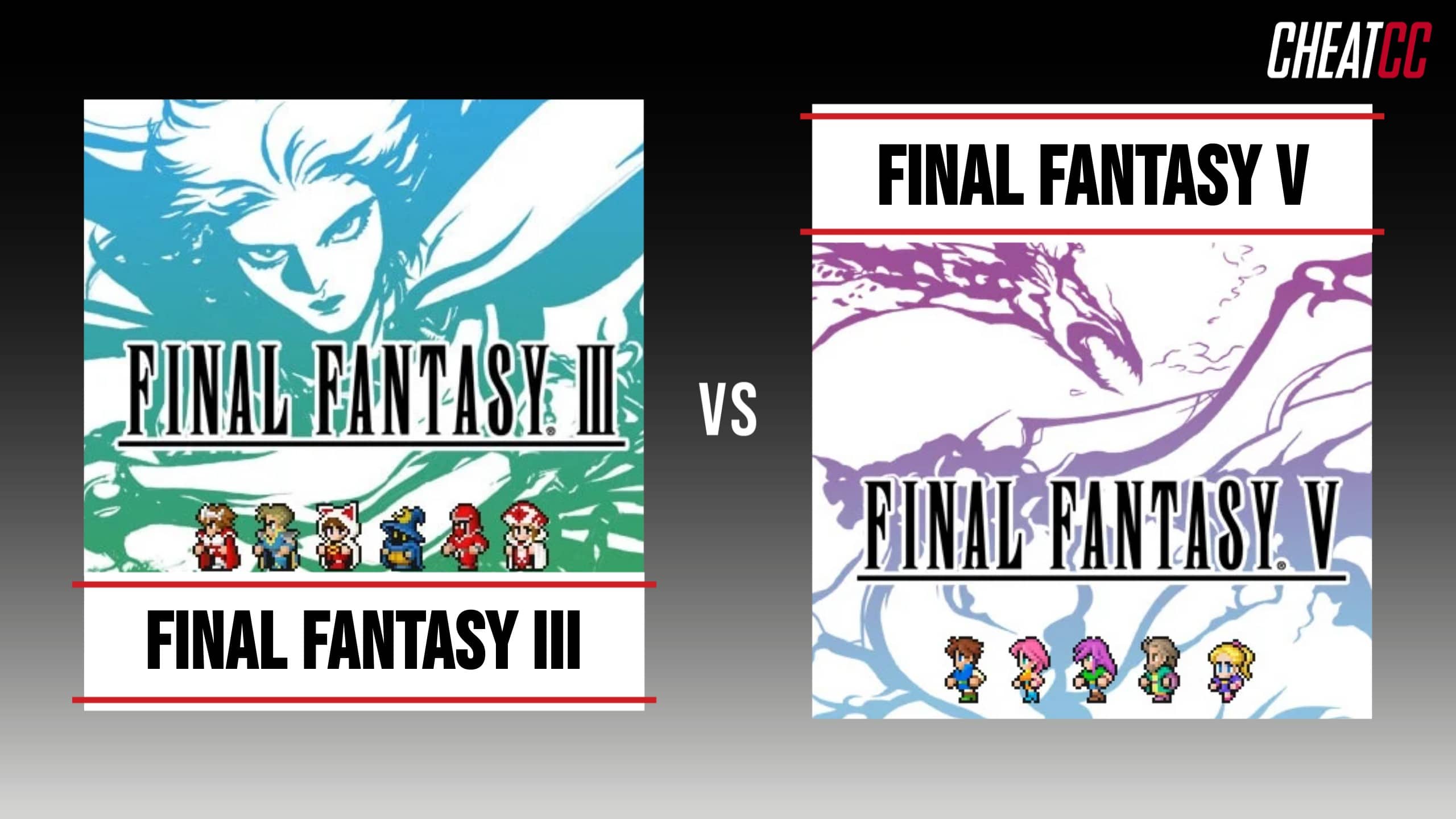After the original Final Fantasy‘s adoption of a more traditional pen-and-paper RPG-style class system, Final Fantasy II would introduce characters that could essentially have free reign in how they develop. Of course, that game’s character progression and leveling meant players would earn the freedom to craft their ideal party at the cost of needing to endlessly grind and subject themselves to the tedium of using weapons and spells over and over to enhance their skill. In going back to the drawing board, Final Fantasy III would arrive with one of the series’ best contributions to the genre — the Job system. And, Final Fantasy V would release just a few years later with an arguably better iteration of it. So it begs the question, then, of which Job system-using game reigns supreme in the series, pitting Final Fantasy III vs Final Fantasy V.
The Job system is so ingenious that it’s a wonder why it hadn’t been implemented prior to Final Fantasy III‘s release, and its inclusion in Final Fantasy V is nothing short of a revelation. In just a few short years, the developers at Square were able to introduce so many new wrinkles to the mechanics and elements of the Job system as to almost completely reinvent it, with the most significant contribution being the ability to mix and match skills from different jobs. Thanks to Final Fantasy V‘s innovations, this same principle would eventually remain one of the core mechanics of the best Job system in the series — Final Fantasy Tactics.
Many of the current top-level creative minds at Square Enix cite Final Fantasy V as their favorite game in the series (as does its director and Final Fantasy creator, Hironobu Sakaguchi), and its gameplay does more than enough heavy lifting to illustrate why.
Final Fantasy III vs Final Fantasy V: Side-by-Side Comparison

Despite releasing only 2 years apart (with Final Fantasy III arriving in 1990 and Final Fantasy V in 1992), there’s a massive technological and mechanical leap that exists between the third and fifth games in the Final Fantasy series. The fourth game in the series would elevate the franchise’s storytelling to previously unseen heights and also introduce the revolutionary Active-Time Battle (ATB) system that made turn-based combat more engaging. Thanks to those two innovations, Final Fantasy V‘s return to the Job system makes the game feel like it borrows the best parts of both Final Fantasy III and Final Fantasy IV. Players have the freedom to craft their party however they like using the Job system, but there’s also a much greater emphasis on story and character development than players will find in Final Fantasy III.
| Characteristic | Final Fantasy III | Final Fantasy V |
|---|---|---|
| Release Date | April 27, 1990 | December 6, 1992 |
| Release Platform | Famicom | Super Famicom |
| Director | Hironobu Sakaguchi | Hironobu Sakaguchi |
| Producer | Masafumi Miayamoto | Hiroyuki Ito |
| Review Aggregate Score | 90% | 76% |
| Number of Jobs | 22 | 22 |
| Melee vs Magic Jobs | 11/11 | 10/12 |
| Can Mix & Match Job Abilities | ✅ | |
| Ports, Remasters, Remakes | 4 ports, 1 remake (Nintendo DS), 1 remaster (Pixel Remaster) | 7 ports, 1 remaster (Pixel Remaster) |
| Total Sales | 5.75 million units | 4.21 million units |
Final Fantasy III vs Final Fantasy V: 5 Must-Know Facts
Here are 5 must-know facts when comparing the Job systems of Final Fantasy III and Final Fantasy V:
- Despite each game having their own unique Jobs, both FFIII and FFV share many similar Jobs between their two iterations of the Job system. Additionally, both games feature the same amount of Jobs, with both titles having 22 different options for players to unlock.
- While Final Fantasy III would introduce the Job system and provide players more freedom in developing their party than in any other contemporary RPG, Final Fantasy V takes this a step further by allowing players to mix and match secondary abilities from different Jobs.
- Similarly, even though Final Fantasy III is the first game in the series to implement the Job system, Final Fantasy V improves on the system in nearly every way. In fact, there are more similarities between Final Fantasy V and Final Fantasy Tactics‘ implementation of the system than FFT and FFIII.
- Both titles would feature direction from Final Fantasy creator Hironobu Sakaguchi, but Final Fantasy V would end up being the creator’s last spin in the director’s chair until providing a more hands-on role as a producer and a designer on Final Fantasy IX. As a result, he lists Final Fantasy V as perhaps his favorite game in the series and the culmination of his work.
- Since the release of both Final Fantasy III and Final Fantasy V, several other RPGs (both within the series and outside it) have gone on to implement their own spin on the iconic Job system. Final Fantasy Tactics, widely considered to be the best spin-off in the series, takes more inspiration from Final Fantasy V‘s version of the Job system than FFIII‘s.
Final Fantasy III vs Final Fantasy V: Number of Jobs
Despite it arriving 2 years after FFIII, Final Fantasy V doesn’t actually increase the total number of available jobs over its predecessor. Both titles feature a grand total of 22 available Jobs for players to unlock, and even their split between melee and magic-focused jobs is fairly even. Final Fantasy III divides its melee and magic jobs with an even 11 of each, while Final Fantasy V features a slightly more askew ratio of 10 melee Jobs versus 12 magic Jobs. Interestingly, while the ports and remakes of Final Fantasy III don’t feature any additional Jobs (with the DS remake replacing Onion Knight with Freelancer), the Game Boy Advance port of Final Fantasy V adds in 3 exclusive Jobs to bring its grand total up to 25.
Final Fantasy III vs Final Fantasy V: Mixing and Matching Abilities
The most critical difference between both games’ utilization of the Job system is Final Fantasy V‘s implementation of being able to mix and match abilities from different Jobs. In Final Fantasy III, players would need to equip a certain Job and would then be locked into using the abilities for that Job. In order to change up their primary and secondary abilities, players would then need to also change Jobs. Conversely, in Final Fantasy V, players will learn primary and secondary abilities for each Job they equip, and those secondary abilities become equippable into a character’s skill loadout after mastering the ability. In one example, Monk’s have the bare-handed secondary ability that increases attack power when not equipping any weapons, and players can learn that ability as a Monk and then switch to any other Job and negate equipment to deal massive damage.
Final Fantasy III vs Final Fantasy V: Invention or Refinement
Final Fantasy V would undoubtedly introduce several significant improvements to the Job system introduced in Final Fantasy III, even if it borrows liberally from that game and its roster of equippable Jobs in the process. Still, FFIII would walk so that FFV could run, and it’s hard to argue against the importance of the game with how profoundly the Job system mechanic continues to shape the RPG genre. Tryingt o determine which of these Final Fantasy games has the better Job system almost requires one to completely ignore the innovation and impact on display in the Job system’s first appearance, and that’s simply not possible given how many other games in the genre continue to implement their own version of Final Fantasy III‘s groundbreaking class system.
Final Fantasy III vs Final Fantasy V: Influencing Modern Job Systems
Speaking of other RPGs utilizing a Job system for their class assignments, the idea of differentiating traditional RPG class archetypes as assignable Jobs to characters is an idea that still pervades throughout the genre to this day. Beyond Final Fantasy V (which would be the first and most obvious game to benefit from Final Fantasy III), the legendary Final Fantasy Tactics would introduce the mechanic to a much larger audience and continue to see its influence felt across most (if not all) tactical RPGs that come after it. Were it not for FFIII and FFV, it’s highly likely that fans would have never gotten Final Fantasy Tactics, and in that scenario the world of TRPG/SRPG titles looks drastically different.
Bottom Line
Job systems in RPGs are an excellent way to allow the player freedom of expression in terms of how they craft their ideal party. Additionally, they add significant replay value to experiences that are traditionally “one-and-done”, giving incentive for players to try out new strategems and builds to see the impact it has on their playthrough firsthand. Without the introduction of the Job system in Final Fantasy III, and the refinements to that system present in Final Fantasy V, it’s not just possible but highly probable that RPGs would look drastically different today.
Still, Final Fantasy III‘s Job system acts as something of a “proof of concept” for the eventual perfection of the idea in Final Fantasy V, which would both serve as a primary inspiration for Final Fantasy Tactics and virtually every other RPG that utilizes a Job-based class system. For that reason, Final Fantasy V is the best classic series title using the Job system mechanic.
